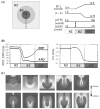Modeling cardiac ischemia
- PMID: 17132797
- PMCID: PMC3313589
- DOI: 10.1196/annals.1380.029
Modeling cardiac ischemia
Abstract
Myocardial ischemia is one of the main causes of sudden cardiac death, with 80% of victims suffering from coronary heart disease. In acute myocardial ischemia, the obstruction of coronary flow leads to the interruption of oxygen flow, glucose, and washout in the affected tissue. Cellular metabolism is impaired and severe electrophysiological changes in ionic currents and concentrations ensue, which favor the development of lethal cardiac arrhythmias such as ventricular fibrillation. Due to the burden imposed by ischemia in our societies, a large body of research has attempted to unravel the mechanisms of initiation, sustenance, and termination of cardiac arrhythmias in acute ischemia, but the rapidity and complexity of ischemia-induced changes as well as the limitations in current experimental techniques have hampered evaluation of ischemia-induced alterations in cardiac electrical activity and understanding of the underlying mechanisms. Over the last decade, computer simulations have demonstrated the ability to provide insight, with high spatiotemporal resolution, into ischemic abnormalities in cardiac electrophysiological behavior from the ionic channel to the whole organ. This article aims to review and summarize the results of these studies and to emphasize the role of computer simulations in improving the understanding of ischemia-related arrhythmias and how to efficiently terminate them.
Figures





References
-
- Zipes DP, Wellens HJJ. Sudden cardiac death. Circulation. 1998;98:2334–2351. - PubMed
-
- Carmeliet E. Cardiac ionic currents and acute ischemia: from channels to arrhythmias. Physiol Rev. 1999;79:917–1017. - PubMed
-
- Harris AS, Bisteni A, Russell RA, et al. Excitatory factors in ventricular tachycardia resulting from myocardial ischemia. Potassium a major excitant. Science. 1954;119:200–203. - PubMed
-
- Wit AL, Janse MJ. Experimental models of ventricular tachycardia and fibrillation caused by ischemia and infarction. Circulation. 1992;85(Suppl I):I32–I42. - PubMed
Publication types
MeSH terms
Grants and funding
LinkOut - more resources
Full Text Sources
Other Literature Sources

